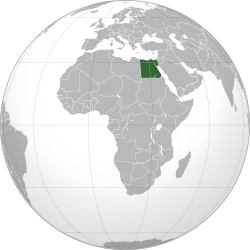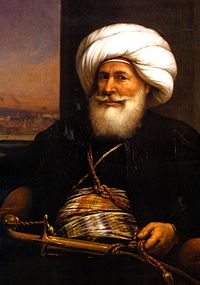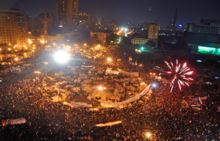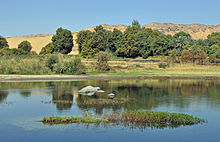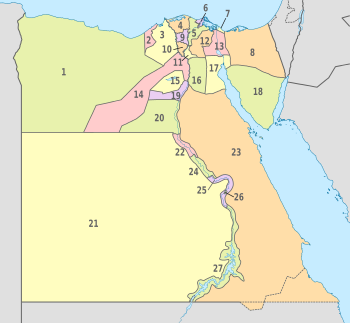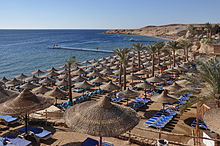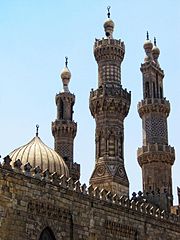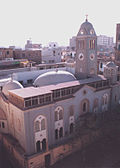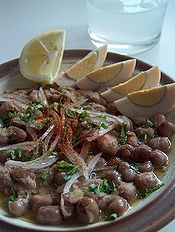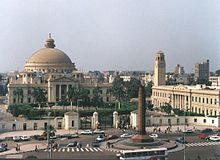
Egypt
Background to the schools Wikipedia
The articles in this Schools selection have been arranged by curriculum topic thanks to SOS Children volunteers. SOS Children works in 45 African countries; can you help a child in Africa?
| Arab Republic of Egypt جمهورية مصر العربية
Ǧumhūriyyat Maṣr al-ʿArabiyyah |
||||||
|---|---|---|---|---|---|---|
|
||||||
| Anthem: Bilady, Bilady, Bilady My country, my country, my country |
||||||
|
|
||||||
| Capital and largest city |
Cairo 30°2′N 31°13′E |
|||||
| Official languages | Arabic | |||||
| Demonym | Egyptian | |||||
| Government | Unitary semi-presidential republic | |||||
| - | President | Mohamed Morsi | ||||
| - | Prime Minister | Hesham Kandil | ||||
| Legislature | Parliament | |||||
| - | Upper house | Shura Council | ||||
| - | Lower house | House of Representatives | ||||
| Establishment | ||||||
| - | Unification of Upper and Lower Egypt |
c. 3200 BC | ||||
| - | Muhammad Ali Dynasty inaugurated | 9 July 1805 | ||||
| - | Independence from the United Kingdom |
28 February 1922 | ||||
| - | Republic declared | 18 June 1953 | ||||
| Area | ||||||
| - | Total | 1,002,450 km2 ( 30th) 387,048 sq mi |
||||
| - | Water (%) | 0.632 | ||||
| Population | ||||||
| - | 2011 estimate | 79,602,000 ( 15th) | ||||
| - | 2006 census | 72,798,000 | ||||
| - | Density | 76.3/km2 ( 126th) 197.5/sq mi |
||||
| GDP ( PPP) | 2012 estimate | |||||
| - | Total | $533.739 billion | ||||
| - | Per capita | $6,594 | ||||
| GDP (nominal) | 2012 estimate | |||||
| - | Total | $252.458 billion | ||||
| - | Per capita | $3,118 | ||||
| Gini (2008) | 30.8 medium |
|||||
| HDI (2011) | medium · 113th |
|||||
| Currency | Egyptian pound ( EGP) |
|||||
| Time zone | EET ( UTC+2b) | |||||
| Drives on the | right | |||||
| Calling code | +20 | |||||
| ISO 3166 code | EG | |||||
| Internet TLD |
|
|||||
| a. | ^ Literary Arabic is the sole official language. Egyptian Arabic is the national spoken language. Other dialects and minority languages are spoken regionally. | |||||
| b. | No daylight saving time has been kept since 2011. | |||||
Egypt / ˈ iː dʒ ɪ p t / (Arabic: مصر Miṣr), officially the Arab Republic of Egypt (Arabic: جمهورية مصر العربية), is a transcontinental country spanning the northeast corner of Africa and southwest corner of Asia via a land bridge formed by the Sinai Peninsula. Most of its territory of 1,010,000 square kilometers (390,000 sq mi) lies within North Africa and is bordered by the Mediterranean Sea to the north, the Gaza Strip and Israel to the northeast, the Red Sea to the east, Sudan to the south and Libya to the west.
Egypt is one of the most populous countries in Africa and the Middle East, and the 15th most populated in the world. The great majority of its over 82 million people live near the banks of the Nile River, an area of about 40,000 square kilometers (15,000 sq mi), where the only arable land is found. The large regions of the Sahara Desert, which constitute most of Egypt's territory, are sparsely inhabited. About half of Egypt's residents live in urban areas, with most spread across the densely populated centres of greater Cairo, Alexandria and other major cities in the Nile Delta.
Egypt has one of the longest histories of any modern state, having been continuously inhabited since the 10th millennium BCE. Its monuments, such as the Giza pyramid complex and its Great Sphinx, were constructed by its ancient civilization, which was one of the most advanced of its time. Its ancient ruins, such as those of Memphis, Thebes, Karnak, and the Valley of the Kings outside Luxor, are a significant focus of archaeological study and popular interest. Egypt's rich cultural legacy, as well as the attraction of its Red Sea Riviera, has made tourism a vital part of the economy, employing about 12% of the country's workforce.
The economy of Egypt is one of the most diversified in the Middle East, with sectors such as tourism, agriculture, industry and services at almost equal production levels. Egypt is considered to be a middle power, with significant cultural, political, and military influence in the Mediterranean, the Middle East and the Muslim world.
Names
The English name Egypt is derived from the ancient Greek Aígyptos (Αἴγυπτος), via Middle French Egypte and Latin Aegyptus. It is reflected in early Greek Linear B tablets as a-ku-pi-ti-yo. The adjective aigýpti-, aigýptios was borrowed into Coptic as gyptios, , and from there into Arabic as qubṭī, back formed into قبة qubṭ, whence English Copt. The Greek forms were borrowed from Late Egyptian (Amarna) Hikuptah "Memphis", a corruption of the earlier Egyptian name Hwt-ka-Ptah (ḥwt-k-ptḥ), meaning "home of the ka (soul) of Ptah", the name of a temple to the god Ptah at Memphis. Strabo attributed the word to a folk etymology in which Aígyptos (Αἴγυπτος) evolved as a compound from Aigaiou huptiōs (Aἰγαίου ὑπτίως), meaning "below the Aegean".
Miṣr (IPA: [mesˤr]) is the Literary Arabic and modern official name of Egypt, while Maṣr (IPA: [mɑsˤɾ]) is the common pronunciation in Egyptian Arabic. The name is of Semitic origin, directly cognate with other Semitic words for Egypt such as the Hebrew מִצְרַיִם (Mitzráyim), literally meaning "the two straits" (a reference to the dynastic separation of upper and lower Egypt). The word originally connoted "metropolis" or "civilization" and means "country", or "frontier-land".
The ancient Egyptian name of the country is Kemet ( km.t) ⟨𓆎𓅓𓏏𓊖⟩, which means "black land", referring to the fertile black soils of the Nile flood plains, distinct from the deshret (dšṛt), or "red land" of the desert. The name is realized as kēme and kēmə in the Coptic stage of the Egyptian language, and appeared in early Greek as Χημία (Khēmía). Another name was tꜣ-mry "land of the riverbank". The names of Upper and Lower Egypt were Ta-Sheme'aw (tꜣ-šmꜥw) "sedgeland" and Ta-Mehew (tꜣ mḥw) "northland", respectively.
History
Prehistory and Ancient Egypt
There is evidence of rock carvings along the Nile terraces and in desert oases. In the 10th millennium BC, a culture of hunter-gatherers and fishers was replaced by a grain-grinding culture. Climate changes and/or overgrazing around 8000 BC began to desiccate the pastoral lands of Egypt, forming the Sahara. Early tribal peoples migrated to the Nile River where they developed a settled agricultural economy and more centralized society.
By about 6000 BC, a Neolithic culture rooted in the Nile Valley. During the Neolithic era, several predynastic cultures developed independently in Upper and Lower Egypt. The Badarian culture and the successor Naqada series are generally regarded as precursors to dynastic Egypt. The earliest known Lower Egyptian site, Merimda, predates the Badarian by about seven hundred years. Contemporaneous Lower Egyptian communities coexisted with their southern counterparts for more than two thousand years, remaining culturally distinct, but maintaining frequent contact through trade. The earliest known evidence of Egyptian hieroglyphic inscriptions appeared during the predynastic period on Naqada III pottery vessels, dated to about 3200 BC.

A unified kingdom was founded c. 3150 BC by King Menes, leading to a series of dynasties that ruled Egypt for the next three millennia. Egyptian culture flourished during this long period and remained distinctively Egyptian in its religion, arts, language and customs. The first two ruling dynasties of a unified Egypt set the stage for the Old Kingdom period, c. 2700–2200 BC., which constructed many pyramids, most notably the Third Dynasty pyramid of Djoser and the Fourth Dynasty Giza Pyramids.
The First Intermediate Period ushered in a time of political upheaval for about 150 years. Stronger Nile floods and stabilization of government, however, brought back renewed prosperity for the country in the Middle Kingdom c. 2040 BC, reaching a peak during the reign of Pharaoh Amenemhat III. A second period of disunity heralded the arrival of the first foreign ruling dynasty in Egypt, that of the Semitic Hyksos. The Hyksos invaders took over much of Lower Egypt around 1650 BC and founded a new capital at Avaris. They were driven out by an Upper Egyptian force led by Ahmose I, who founded the Eighteenth Dynasty and relocated the capital from Memphis to Thebes.
The New Kingdom c. 1550–1070 BC began with the Eighteenth Dynasty, marking the rise of Egypt as an international power that expanded during its greatest extension to an empire as far south as Tombos in Nubia, and included parts of the Levant in the east. This period is noted for some of the most well known Pharaohs, including Hatshepsut, Thutmose III, Akhenaten and his wife Nefertiti, Tutankhamun and Ramesses II. The first historically attested expression of monotheism came during this period as Atenism. Frequent contacts with other nations brought new ideas to the New Kingdom. The country was later invaded and conquered by Libyans, Nubians and Assyrians, but native Egyptians eventually drove them out and regained control of their country.
The Thirtieth Dynasty was the last native ruling dynasty during the Pharaonic epoch. It fell to the Persians in 343 BC after the last native Pharaoh, King Nectanebo II, was defeated in battle.
Ptolemaic and Roman Egypt

The Ptolemaic Kingdom was a powerful Hellenistic state, extending from southern Syria in the east, to Cyrene to the west, and south to the frontier with Nubia. Alexandria became the capital city and a centre of Greek culture and trade. To gain recognition by the native Egyptian populace, they named themselves as the successors to the Pharaohs. The later Ptolemies took on Egyptian traditions, had themselves portrayed on public monuments in Egyptian style and dress, and participated in Egyptian religious life.
The last ruler from the Ptolemaic line was Cleopatra VII, who committed suicide following the burial of her lover Mark Antony who had died in her arms (from a self-inflicted stab wound), after Octavian had captured Alexandria and her mercenary forces had fled. The Ptolemies faced rebellions of native Egyptians often caused by an unwanted regime and were involved in foreign and civil wars that led to the decline of the kingdom and its annexation by Rome. Nevertheless Hellenistic culture continued to thrive in Egypt well after the Muslim conquest.
Christianity was brought to Egypt by Saint Mark the Evangelist in the 1st century. Diocletian's reign marked the transition from the Roman to the Byzantine era in Egypt, when a great number of Egyptian Christians were persecuted. The New Testament had by then been translated into Egyptian. After the Council of Chalcedon in AD 451, a distinct Egyptian Coptic Church was firmly established.
Middle Ages
The Byzantines were able to regain control of the country after a brief Persian invasion early in the 7th century, until 639–42, when Egypt was invaded and conquered by the Islamic Empire by the Muslim Arabs. When they defeated the Byzantine Armies in Egypt, the Arabs brought Sunni Islam to the country. Early in this period, Egyptians began to blend their new faith with indigenous beliefs and practices, leading to various Sufi orders that have flourished to this day. These earlier rites had survived the period of Coptic Christianity.
Muslim rulers nominated by the Islamic Caliphate remained in control of Egypt for the next six centuries, with Cairo as the seat of the Caliphate under the Fatimids. With the end of the Kurdish Ayyubid dynasty, the Mamluks, a Turco- Circassian military caste, took control about AD 1250. By the late 13th century, Egypt linked the Red Sea, India, Malaya, and East Indies. The mid-14th-century Black Death killed about 40% of the country's population.
Ottoman Egypt
Egypt was conquered by the Ottoman Turks in 1517, after which it became a province of the Ottoman Empire. The Ottoman invasion pushed the Egyptian system into decline. The defensive militarization damaged its civil society and economic institutions. The weakening of the economic system combined with the effects of plague left Egypt vulnerable to foreign invasion. Portuguese traders took over their trade. Egypt suffered six famines between 1687 and 1731. The 1784 famine cost it roughly one-sixth of its population.
Muhammad Ali dynasty

The brief French invasion of Egypt led by Napoleon Bonaparte began in 1798. After the French were defeated by the British, a power vacuum was created in Egypt, and a three-way power struggle ensued between the Ottoman Turks, Egyptian Mamluks who had ruled Egypt for centuries, and Albanian mercenaries in the service of the Ottomans. It ended in victory for the Albanians led by Muhammad Ali.
While he carried the title of viceroy of Egypt, his subordination to the Ottoman porte was merely nominal. Muhammad Ali established a dynasty that was to rule Egypt until the revolution of 1952. In later years, the dynasty became a British puppet.
The introduction in 1820 of long-staple cotton transformed its agriculture into a cash-crop monoculture before the end of the century, concentrating land ownership and shifting production towards international markets.
Muhammad Ali annexed Northern Sudan (1820–1824), Syria (1833), and parts of Arabia and Anatolia; but in 1841 the European powers, fearful lest he topple the Ottoman Empire itself, forced him to return most of his conquests to the Ottomansy. His military ambition required him to modernize the country: he built industries, a system of canals for irrigation and transport, and reformed the civil service.
Muhammad Ali was succeeded briefly by his son Ibrahim (in September 1848), then by a grandson Abbas I (in November 1848), then by Said (in 1854), and Isma'il (in 1863).
The Suez Canal, built in partnership with the French, was completed in 1869. Its construction led to enormous debt to European banks, and caused popular discontent because of the onerous taxation it required. In 1875 Ismail was forced to sell Egypt's share in the canal to the British Government. Within three years this led to the imposition of British and French controllers who sat in the Egyptian cabinet, and, "with the financial power of the bondholders behind them, were the real power in the Government."
Local dissatisfaction with Ismail and with European intrusion led to the formation of the first nationalist groupings in 1879, with Ahmad Urabi a prominent figure. Fearing a reduction of their control, the UK and France intervened militarily, bombarding Alexandria and crushing the Egyptian army at the battle of Tel el-Kebir. They reinstalled Ismail's son Tewfik as figurehead of a de facto British protectorate. In 1906, the Dinshaway Incident prompted many neutral Egyptians to join the nationalist movement.
In 1914, the Protectorate was made official, and the title of the head of state was changed to sultan, to repudiate the vestigial suzerainty of the Ottoman sultan, who was backing the Central powers in World War I. Abbas II was deposed as khedive and replaced by his uncle, Hussein Kamel, as sultan.
After the First World War, Saad Zaghlul and the Wafd Party led the Egyptian nationalist movement to a majority at the local Legislative Assembly. When the British exiled Zaghlul and his associates to Malta on 8 March 1919, the country arose in its first modern revolution. The revolt led the UK government to issue a unilateral declaration of Egypt's independence on 22 February 1922.
The new government drafted and implemented a constitution in 1923 based on a parliamentary system. Saad Zaghlul was popularly elected as Prime Minister of Egypt in 1924. In 1936, the Anglo-Egyptian Treaty was concluded. Continued instability due to remaining British influence and increasing political involvement by the king led to the dissolution of the parliament in a military coup d'état known as the 1952 Revolution. The Free Officers Movement forced King Farouk to abdicate in support of his son Fuad. British military presence in Egypt lasted until 1954.
Republic
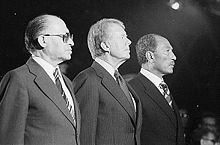
On 18 June 1953, the Egyptian Republic was declared, with General Muhammad Naguib as the first President of the Republic. Naguib was forced to resign in 1954 by Gamal Abdel Nasser – the real architect of the 1952 movement – and was later put under house arrest. Nasser assumed power as President in June 1956. British forces completed their withdrawal from the occupied Suez Canal Zone on 13 June 1956. He nationalized the Suez Canal on 26 July 1956, prompting the 1956 Suez Crisis.
In 1958, Egypt and Syria formed a sovereign union known as the United Arab Republic. The union was short-lived, ending in 1961 when Syria seceded, thus ending the union. During most of its existence, the United Arab Republic was also in a loose confederation with North Yemen (formerly the Mutawakkilite Kingdom of Yemen) known as the United Arab States.
In the 1967 Six Day War, Israel invaded and occupied Egypt's Sinai Peninsula and the Gaza Strip, which Egypt had occupied since the 1948 Arab–Israeli War. During the 1967 war an Emergency Law was enacted, and remained in effect until 2012, with the exception of an 18-month break in 1980/81.
Three years later (1970) President Nasser died and was succeeded by Anwar Sadat in 1970. Sadat switched Egypt's Cold War allegiance from the Soviet Union to the United States, expelling Soviet advisors in 1972. He launched the Infitah economic reform policy, while clamping down on religious and secular opposition. In 1973, Egypt, along with Syria, launched the October War, a surprise attack to regain part of the Sinai territory Israel had captured 6 years earlier. While the war ended with a military stalemate, it presented Sadat with a political victory that later allowed him to regain the Sinai in return for peace with Israel.
Sadat made a historic visit to Israel in 1977, which led to the 1979 peace treaty in exchange for Israeli withdrawal from Sinai. Sadat's initiative sparked enormous controversy in the Arab world and led to Egypt's expulsion from the Arab League, but it was supported by most Egyptians. However, Sadat was assassinated by an Islamic extremist. Hosni Mubarak came to power after the assassination of Sadat.
In late February 2005, Mubarak announced a reform of the presidential election law, paving the way for multi-candidate polls for the first time since the 1952 movement. However, the new law placed restrictions on the candidates, and led to his easy re-election victory. Voters turnout was less than 25%. Elections observers also alleged government interference in the election process. After the election, Mubarak imprisoned Ayman Nour, the runner-up.
HRW's 2006 report on Egypt detailed serious human rights violations, including routine torture, arbitrary detentions and trials before military and state security courts. In 2007, Amnesty International released a report alleging that Egypt had become an international centre for torture, where other nations send suspects for interrogation, often as part of the War on Terror. Egypt's foreign ministry quickly issued a rebuttal to this report.
Constitutional changes voted on 19 March 2007 prohibited parties from using religion as a basis for political activity, allowed the drafting of a new anti-terrorism law, authorized broad police powers of arrest and surveillance, gave the president power to dissolve parliament and end judicial election monitoring. In 2009, Dr. Ali El Deen Hilal Dessouki, Media Secretary of the NDP, described Egypt as a "pharaonic" political system, and democracy as a "long term goal". Dessouki also stated that "the real centre of power in Egypt is the military".
Revolution
On 25 January 2011, widespread protests began against Mubarak's government. On 11 February 2011, Mubarak resigned and fled Cairo. Jubilant celebrations broke out in Tahrir Square at the news. The Egyptian military then assumed the power to govern. Mohamed Hussein Tantawi, chairman of the Supreme Council of the Armed Forces, became the de facto interim head of state. On 13 February 2011, the new military dissolved the parliament and suspended the constitution.
A constitutional referendum was held on 19 March 2011. On 28 November 2011, Egypt held its first parliamentary election since the previous regime had been in power. Turnout was high and there were no reports of major irregularities or violence. Mohamed Morsi was elected president on 24 June 2012. On 2 August 2012, Egypt’s Prime Minister Hisham Qandil announced his 35 member cabinet comprising 28 newcomers including four from the Muslim Brotherhood.
Liberal and secular groups walked out of the constituent assembly because they believed that it would impose strict Islamic practices, while Muslim Brotherhood backers threw their support behind Morsi. On 22 November 2012, President Morsi issued a declaration immunizing his decrees from challenge and seeking to protect the work of the constituent assembly.
The move has led to massive protests and violent action throughout Egypt. On 5 December 2012, tens of thousands of supporters and opponents of Egypt's president clashed, in what was described as the largest violent battle between Islamists and their foes since the country's revolution. Mohamed Morsi offered a "national dialogue" with opposition leaders but refused to cancel the December 2012 constitutional referendum.
Geography
Egypt lies primarily between latitudes 22° and 32°N, and longitudes 25° and 35°E. At 1,001,450 square kilometers (386,660 sq mi), it is the world's 30th-largest country. Nevertheless, due to the aridity of Egypt's climate, population centres are concentrated along the narrow Nile Valley and Delta, meaning that about 99% of the population uses only about 5.5% of the total land area. 98% of Egyptians live on 3% of the territory.
Egypt is bordered by Libya to the west, Sudan to the south, and by the Gaza Strip and Israel to the east. Egypt's important role in geopolitics stems from its strategic position: a transcontinental nation, it possesses a land bridge (the Isthmus of Suez) between Africa and Asia, traversed by a navigable waterway (the Suez Canal) that connects the Mediterranean Sea with the Indian Ocean by way of the Red Sea.
Apart from the Nile Valley, the majority of Egypt's landscape is desert, with a few oases scattered about. Winds create prolific sand dunes that peak at more than 100 feet (30 m) high. Egypt includes parts of the Sahara Desert and of the Libyan Desert. These deserts that protected the Kingdom of the Pharaohs from western threats were referred to as the "red land" in ancient Egypt.
Towns and cities include Alexandria, the second largest city; Aswan; Asyut; Cairo, the modern Egyptian capital and largest city; El-Mahalla El-Kubra; Giza, the site of the Pyramid of Khufu; Hurghada; Luxor; Kom Ombo; Port Safaga; Port Said; Sharm el Sheikh; Suez, where the Suez Canal is located; Zagazig; and Al-Minya. Oases include Bahariya, el Dakhla, Farafra, el Kharga and Siwa. Protectorates include Ras Mohamed National Park, Zaranik Protectorate and Siwa.
See Egyptian Protectorates for more information.
Climate
Most of Egypt's rain falls in the winter months. South of Cairo, rainfall averages only around 2 to 5 mm (0.1 to 0.2 in) per year and at intervals of many years. On a very thin strip of the northern coast the rainfall can be as high as 410 mm (16.1 in), mostly between October and March. Snow falls on Sinai's mountains and some of the north coastal cities such as Damietta, Baltim, Sidi Barrany, etc. and rarely in Alexandria. Frost is also known in mid-Sinai and mid-Egypt.
Temperatures average between 80 and 90 °F (26.7 and 32.2 °C) in summer, and up to 109 °F (43 °C) on the Red Sea coast. Winter temperatures average between 55 and 70 °F (13 and 21 °C). A steady wind from the northwest helps lower temperatures near the Mediterranean coast. The Khamaseen is a wind that blows from the south in spring, bringing sand and dust, and sometimes raises the temperature in the desert to more than 100 °F (38 °C).
Prior to the construction of the Aswan Dam, the Nile flooded annually (colloquially The Gift of the Nile) replenishing Egypt's soil. This gave the country consistent harvest throughout the years.
The potential rise in sea levels due to global warming could threaten Egypt's densely populated coastal strip and have grave consequences for the country's economy, agriculture and industry. Combined with growing demographic pressures, a significant rise in sea levels could turn millions of Egyptians into environmental refugees by the end of the century, according to some climate experts.
Biodiversity
Egypt signed the Rio Convention on Biological Diversity on 9 June 1992, and became a party to the convention on 2 June 1994. It has subsequently produced a National Biodiversity Strategy and Action Plan, which was received by the convention on 31 July 1998. Where many CBD National Biodiversity Strategy and Action Plans neglect biological kingdoms apart from animals and plants, Egypt's plan was unusual in providing balanced information about all forms of life.
The plan stated that the following numbers of species of different groups had been recorded from Egypt: algae (1483 species), animals (about 15,000 species of which more than 10,000 were insects), fungi (more than 627 species), monera (319 species), plants (2426 species), protozoans (371 species). For some major groups, for example lichen-forming fungi and nematode worms, the number was not known. Apart from small and well-studied groups like amphibians, birds, fish, mammals and reptiles, the many of those numbers are likely to increase as further species are recorded from Egypt. For the fungi, including lichen-forming species, for example, subsequent work has shown that over 2200 species have been recorded from Egypt, and the final figure of all fungi actually occurring in the country is expected to be much higher.
Politics
The Egyptian parliament is bicameral, consisting of the Shura Council, elected for six-year terms, and the House of Representatives, whose members are elected to serve five-year terms. Elections were last held between November 2011 and January 2012; elections for the House of Representatives will be held in early 2013; while election for the Shura Council are to be held within one year.
In the latest elections to the Shura Council, the Democratic Alliance for Egypt won 105 seats, the Alliance for Egypt 45 seats, the New Wafd Party 14, the Egyptian Bloc 8, while other parties and independents held 8 seats. Presidential appointees held 9 seats. In the House of Representatives, the Democratic Alliance of Egypt holds 235 seats, Alliance for Egypt 123, New Wafd Party 38, Egyptian Bloc 35, Al-Wasat 10, Reform and Development Party 9, The Revolution Continues Alliance 8, National Party of Egypt 5, Egyptian Citizen Party 4, Freedom Party 4, while other parties and independents held 27 seats. SCAF appointees held 10 seats.
On 24 June 2012, Egypt's election commission announced that Muslim Brotherhood candidate Mohammed Morsi had won Egypt's presidential runoff. Morsi won by a narrow margin over Ahmed Shafiq, the last prime minister under deposed leader Hosni Mubarak. The commission said Morsi took 51.7 percent of the vote versus 48.3 for Shafiq. Morsi was sworn in Saturday 30 June 2012, as Egypt's first democratically elected president.
Prime Minister Ahmed Shafik was sworn in as Prime Minister on 29 January 2011, following the resignation of Ahmed Nazif. Since President Mubarak's resignation during the 2011 revolution, Egypt's de facto government has been the Supreme Council of the Armed Forces, chaired by Mohamed Hussein Tantawi.
In 2013, the Freedom House rated political rights in Egypt at "5" (with 1 representing the most free and 7 the least), civil liberties as "5" and gave it the freedom rating of "Partly Free."
Egyptian nationalism predates its Arab counterpart by many decades, having roots in the 19th century and becoming the dominant mode of expression of Egyptian anti-colonial activists and intellectuals until the early 20th century. The ideology espoused by Islamists such as the Muslim Brotherhood is present in small segments of the lower-middle strata of Egyptian society.
Egypt has the oldest continuous parliamentary tradition in the Arab world. The first popular assembly was established in 1866. It was disbanded by the British occupation of 1882, and the British allowed only a consultative body to sit. In 1923, however, after the country’s independence was declared, a new constitution provided for a parliamentary monarchy.
Law
The legal system is based on Islamic and civil law (particularly Napoleonic codes); and that judicial review takes place by a Supreme Court, which accepts compulsory International Court of Justice jurisdiction only with reservations.
Islamic jurisprudence is the principal source of legislation. Sharia courts and qadis are run and licensed by the Ministry of Justice. The personal status law that regulates matters such as marriage, divorce and child custody is governed by Sharia. In a family court, a woman’s testimony is worth half of a man’s testimony.
The Constitution of Egypt was signed into law by President Morsi on 26 December 2012, after it was approved by the Constituent Assembly on 30 November 2012 and passed in a referendum held 15–22 December 2012 with 64% support, but with only 33% electorate participation. It replaced the 2011 Provisional Constitution of Egypt, adopted following the revolution.
The Penal code is unique as it contains a " Blasphemy Law." The present court system allows a death penalty and can be used against individuals tried in absentia. In which case, the court may place an absent person on trial and an Egyptian judge may select a ruling of death. Several Americans and Canadians were provided with this sentence in 2012.
Military
The Egyptian Armed forces have a combined troop strength of around 450,000 active personnel.
According to the Israeli chair of the former Knesset Foreign Affairs and Defense Committee, Yuval Steinitz, the Egyptian Air Force has roughly the same number of modern warplanes as the Israeli Air Force and far more Western tanks, artillery, anti-aircraft batteries and warships than the IDF. Egypt is speculated by Israel to be the second country in the region with a spy satellite, EgyptSat 1.
The United States of America provides an annual military assistance, which in 2009 amounted to US$ 1.3 billion (inflation adjusted US$ 1.41 billion in 2013).
The Egyptian military has dozens of factories manufacturing weapons as well as consumer goods, and it exempts itself from laws that apply to other sectors.
Human rights
The Egyptian Organization for Human Rights is one of the longest-standing bodies for the defence of human rights in Egypt. In 2003, the Government established the National Council for Human Rights. The council came under heavy criticism by local activists, who contend it was a propaganda tool for the Government to excuse its violations and to give legitimacy to repressive laws such as the Emergency Law.
The Pew Forum on Religion & Public Life ranks Egypt as the fifth worst country in the world for religious freedom. The United States Commission on International Religious Freedom has placed Egypt on its watch list for religious freedom that requires close monitoring due to the nature and extent of violations of religious freedom engaged in or tolerated by the government. According to a 2010 Pew Global Attitudes survey, 84% of Egyptians polled supported the death penalty for those who leave Islam; 77% supported whippings and cutting off of hands for theft and robbery; and 82% support stoning people who commit adultery.
Coptic Christians face discrimination at multiple levels of the government, ranging from a disproportional representation in government ministries to laws that limit their ability to build or repair churches. Intolerance of Bahá'ís and unorthodox Muslim sects, such as Sufis and Shi'a, also remains a problem. When the Government moved to computerize identification cards, members of religious minorities, such as Bahá'ís, could not obtain identification documents. An Egyptian court ruled in early 2008 that members of other faiths can obtain identity cards without listing their faiths, and without becoming officially recognized.
Foreign relations
The permanent Headquarters of the Arab League are located in Cairo and the Secretary General of the Arab League has traditionally been Egyptian. Former Foreign Minister Nabil El-Arabi is the current group's Secretary General. The Arab League briefly moved from Egypt to Tunis in 1978 to protest the Egypt-Israel Peace Treaty, returning in 1989.
Egypt was the first Arab state to establish diplomatic relations with Israel, with the signing of the treaty. Despite the peace treaty, Israel is still largely considered an enemy country within Egypt. Egypt has historically played an important role as a mediator in resolving disputes between various Arab states, and in the Israeli-Palestinian dispute. Egypt is a major ally of the United States.
Former Egyptian Deputy Prime Minister Boutros Boutros-Ghali served as Secretary-General of the United Nations from 1991 to 1996.
In the 21st century, Egypt has had a major problem with immigration, as millions of Africans flee poverty and war. Border control methods can be "harsh, sometimes lethal."
Administrative divisions
Egypt is divided into 27 governorates. The governorates are further divided into regions. The regions contain towns and villages. Each governorate has a capital, sometimes carrying the same name as the governorate.
|
|
|
Economy
Egypt's economy depends mainly on agriculture, media, petroleum exports, exports of natural gas, and tourism; there are also more than three million Egyptians working abroad, mainly in Saudi Arabia, the Persian Gulf and Europe. The completion of the Aswan High Dam in 1970 and the resultant Lake Nasser have altered the time-honored place of the Nile River in the agriculture and ecology of Egypt. A rapidly growing population, limited arable land, and dependence on the Nile all continue to overtax resources and stress the economy.
The government has invested in communications and physical infrastructure. Egypt has received U.S. foreign aid (since 1979, an average of $2.2 billion per year) and is the third-largest recipient of such funds from the United States following the Iraq war. Its main revenues however come from tourism as well as traffic that goes through the Suez Canal.
Egypt has a developed energy market based on coal, oil, natural gas, and hydro power. Substantial coal deposits are in the northeast Sinai, and are mined at the rate of about 600,000 metric tons (590,000 long tons; 660,000 short tons) per year. Oil and gas are produced in the western desert regions, the Gulf of Suez, and the Nile Delta. Egypt has huge reserves of gas, estimated at 1,940 cubic kilometres (470 cu mi), and LNG is exported to many countries.
Economic conditions have started to improve considerably after a period of stagnation from the adoption of more liberal economic policies by the Government, as well as increased revenues from tourism and a booming stock market. In its annual report, the International Monetary Fund (IMF) has rated Egypt as one of the top countries in the world undertaking economic reforms. Some major economic reforms taken by the new government since 2003 include a dramatic slashing of customs and tariffs. A new taxation law implemented in 2005 decreased corporate taxes from 40% to the current 20%, resulting in a stated 100% increase in tax revenue by the year 2006.
Foreign direct investment (FDI) into Egypt has increased considerably in the past few years, exceeding $6 billion in 2006, due to the recent economic liberalization and priva tization measures taken by minister of investment Mahmoud Mohieddin.
Although one of the main obstacles still facing the Egyptian economy is the trickle down of the wealth to the average population, many Egyptians criticize their Government for higher prices of basic goods while their standards of living or purchasing power remains relatively stagnant. Corruption is often cited by Egyptians as the main impediment to further economic growth. The Government promises major reconstruction of the country's infrastructure, using money paid for the newly acquired third mobile license ($3 billion) by Etisalat.
Egypt's most prominent multinational companies are the Orascom Group and Raya Contact Centre. The IT sector has expanded rapidly in the past few years, with many start-ups selling outsourcing services to North America and Europe, operating with companies such as Microsoft, Oracle and other major corporations, as well as many small and medium enterprises. Some of these companies are the Xceed Contact Centre, Raya, E Group Connections and C3. The sector has been stimulated by new Egyptian entrepreneurs with Government encouragement.
An estimated 2.7 million Egyptians abroad contribute actively to the development of their country through remittances (US$ 7.8 billion in 2009), as well as circulation of human and social capital and investment.
Egyptian society is moderately unequal in terms of income distribution, with an estimated "35 to 40%" of Egypt's population earning less than the equivalent of $2 a day, while only around 2–3% may be considered wealthy.
Tourism
Tourism is one of the most important sectors in Egypt's economy. More than 12.8 million tourists visited Egypt in 2008, providing revenues of nearly $11 billion. The sector employs about 12% of Egypt's workforce.
Transport
Transport in Egypt is centered in Cairo and largely follow the pattern of settlement along the Nile. The main line of the nation's 40,800-kilometer (25,400 mi) railway network runs from Alexandria to Aswan and is operated by Egyptian National Railways. The badly maintained road network has expanded rapidly to over 21,000 miles, covering the Nile Valley and Nile Delta, Mediterranean and Red Sea coasts, the Sinai, and the Western oases.
The Cairo Metro in Egypt is the first of only two full-fledged metro systems in Africa, and the Arab World. The system consists of three operational lines.
Demographics
| Historical populations in thousands | ||
|---|---|---|
| Year | Pop. | ±% p.a. |
| 1882 | 6,712 | — |
| 1897 | 9,669 | 2.43% |
| 1907 | 11,190 | 1.46% |
| 1917 | 12,718 | 1.28% |
| 1927 | 14,178 | 1.09% |
| 1937 | 15,921 | 1.16% |
| 1947 | 18,967 | 1.75% |
| 1960 | 26,085 | 2.45% |
| 1966 | 30,076 | 2.37% |
| 1976 | 36,626 | 1.97% |
| 1986 | 48,254 | 2.76% |
| 1996 | 59,312 | 2.06% |
| 2006 | 72,798 | 2.05% |
| Source: Population in Egypt | ||
Egypt is the most populated country in the Middle East, and the third most populous on the African continent, with about 80 million inhabitants as of 2009. Its population grew rapidly from 1970 to 2010 due to medical advances and increases in agricultural productivity enabled by the Green Revolution. Egypt's population was estimated at only 3 million when Napoleon invaded the country in 1798.
Egypt's people are highly urbanized, being concentrated along the Nile (notably Cairo and Alexandria), in the Delta and near the Suez Canal. Egyptians are divided demographically into those who live in the major urban centers and the fellahin, or farmers, that reside in rural villages.
Egyptians are by far the largest ethnic group in the country, constituting 91% of the total population. Ethnic minorities include the Abazas, Turks, Greeks, Bedouin Arab tribes living in the eastern deserts and the Sinai Peninsula, the Berber-speaking Siwis (Amazigh) of the Siwa Oasis, and the Nubian communities clustered along the Nile. There are also tribal Beja communities concentrated in the south-eastern-most corner, and a number of Dom clans mostly in the Nile Delta and Faiyum who are progressively becoming assimilated as urbanization increases.
According to the International Organization for Migration, an estimated 2.7 million Egyptians live abroad. Approximately 70% of Egyptian migrants live in Arab countries (923,600 in Saudi Arabia, 332,600 in Libya, 226,850 in Jordan, 190,550 in Kuwait with the rest elsewhere in the region) and the remaining 30% reside mostly in Europe and North America (318,000 in the United States, 110,000 in Canada and 90,000 in Italy).
Egypt also hosts an unknown number of refugees and asylum seekers, estimated to be between 500,000 and 3 million. There are some 70,000 Palestinian refugees, and about 150,000 recently arrived Iraqi refugees, but the number of the largest group, the Sudanese, is contested. The once-vibrant Greek and Jewish communities in Egypt have almost disappeared, with only a small number remaining in the country, but many Egyptian Jews visit on religious occasions and for tourism. Several important Jewish archaeological and historical sites are found in Cairo, Alexandria and other cities.
Languages
The official language of the Republic is Modern Standard Arabic. The spoken languages are: Egyptian Arabic (68%), Sa'idi Arabic (29%), Eastern Egyptian Bedawi Arabic (1.6%), Sudanese Arabic (0.6%), Domari (0.3%), Nobiin (0.3%), Beja (0.1%), Siwi and others. Additionally, Greek, Armenian and Italian are the main languages of immigrants. In Alexandria in the 19th century there was a large community of Italian Egyptians and Italian was the " lingua franca" of the city.
The main foreign languages taught in schools, by order of popularity, are English, French, German and Italian.
Historical Egyptian languages, also known as Copto-Egyptian, consist of ancient Egyptian and Coptic, and form a separate branch among the family of Afro-Asiatic languages. The " Koiné" dialect of the Greek language, though not native to Egypt, was important in Hellenistic Alexandria, and was used extensively in the philosophy and science of that culture, later being the subject of study by Arab scholars.
Religion
Egypt is a predominantly Sunni Muslim country with Islam as its state religion. The percentage of the adherents of various religions is a controversial topic in Egypt. Around 90% are identified as Muslim, 9% are Coptic Christians, and other Christian denominations make up the remaining 1%.
Islam arrived in the 7th century, and Egypt emerged as a centre of politics and culture in the Muslim world. Under Anwar Sadat, Islam became the official state religion and Sharia the main source of law. A significant number of Muslim Egyptians follow native Sufi orders, and there is a minority of Shi'a. Cairo is famous for its numerous mosque minarets and is dubbed "the city of 1,000 minarets".
There is a significant Christian minority in Egypt. Over 90% of Egyptian Christians belong to the native Coptic Orthodox Church of Alexandria, an Oriental Orthodox Church. Other native Egyptian Christians are adherents of the Coptic Catholic Church, the Evangelical Church of Egypt and various other Protestant denominations. Non-native Christian communities are largely found in the urban regions of Cairo and Alexandria.
Egypt hosts two major religious institutions, the Coptic Orthodox Church of Alexandria, established in the middle of the 1st century by Saint Mark the Evangelist, and Al-Azhar University, founded in 970 CE by the Fatimids as the first Islamic University in the world.
Egypt recognizes only three religions: Islam, Christianity, and Judaism. Other faiths practiced by Egyptians, such as the small Bahá'í community, are not recognized by the state. Individuals wishing to include such religions on their state issued identifications are denied (see Egyptian identification card controversy), and had been put in the position of either not obtaining required identification or lying about their faith. A 2008 court ruling allowed members of unrecognized faiths to obtain identification and leave the religion field blank.
Largest cities
| Largest cities or towns of Egypt world-gazetteer estimates for 2012 |
|||||||||
|---|---|---|---|---|---|---|---|---|---|
| Rank | City name | Governorate | Pop. | Rank | City name | Governorate | Pop. | ||
 Cairo |
1 | Cairo | Cairo | 8,105,071 | 11 | Asyut | Asyut | 403,202 |  Giza |
| 2 | Alexandria | Alexandria | 4,388,219 | 12 | Ismailia | Ismailia | 352,411 | ||
| 3 | Giza | Giza | 3,348,401 | 13 | Faiyum | Faiyum | 338,959 | ||
| 4 | Shubra El-Kheima | Qalyubia | 1,072,951 | 14 | Zagazig | Al Sharqia | 314,331 | ||
| 5 | Port Said | Port Said | 607,353 | 15 | Damietta | Damietta | 299,296 | ||
| 6 | Suez | Suez | 547,352 | 16 | Aswan | Aswan | 281,891 | ||
| 7 | Luxor | Luxor | 487,896 | 17 | Minya | Minya | 253,767 | ||
| 8 | Mansoura | Dakahlia | 480,494 | 18 | Damanhour | Beheira | 252,017 | ||
| 9 | El-Mahalla El-Kubra | Gharbia | 458,297 | 19 | Beni Suef | Beni Suef | 223,789 | ||
| 10 | Tanta | Gharbia | 437,793 | 20 | Hurghada | Red Sea | 223,124 | ||
Culture

Egypt is a recognized cultural trend-setter of the Arabic-speaking world, and contemporary Arab culture is heavily influenced by Egyptian literature, music, film and television. Egypt gained a regional leadership role during the 1950s and 1960s, which gave a further enduring boost to the standing of Egyptian culture in the Arab world.
Egyptian identity evolved in the span of this long period of occupation to accommodate Islam and Christianity; and a new language, Arabic, and its spoken descendant, Egyptian Arabic.
The work of early 19th-century scholar Rifa'a al-Tahtawi renewed interest in Egyptian antiquity and exposed Egyptian society to Enlightenment principles. Tahtawi co-founded with education reformer Ali Mubarak a native Egyptology school that looked for inspiration to medieval Egyptian scholars, such as Suyuti and Maqrizi, who themselves studied the history, language and antiquities of Egypt.
Egypt's renaissance peaked in the late 19th and early 20th centuries through the work of people like Muhammad Abduh, Ahmed Lutfi el-Sayed, Muhammad Loutfi Goumah, Tawfiq el-Hakim, Louis Awad, Qasim Amin, Salama Moussa, Taha Hussein and Mahmoud Mokhtar. They forged a liberal path for Egypt expressed as a commitment to personal freedom, secularism and faith in science to bring progress.
Arts
The Egyptians were one of the first major civilizations to codify design elements in art and architecture. Egyptian blue, also known as calcium copper silicate is a pigment used by Egyptians for thousands of years. It is considered to be the first synthetic pigment. The wall paintings done in the service of the Pharaohs followed a rigid code of visual rules and meanings. Egyptian civilization is renowned for its colossal pyramids, temples and monumental tombs. Well-known examples are the Pyramid of Djoser designed by ancient architect and engineer Imhotep, the Sphinx, and the temple of Abu Simbel. Modern and contemporary Egyptian art can be as diverse as any works in the world art scene, from the vernacular architecture of Hassan Fathy and Ramses Wissa Wassef, to Mahmoud Mokhtar's sculptures, to the distinctive Coptic iconography of Isaac Fanous. The Cairo Opera House serves as the main performing arts venue in the Egyptian capital.
Literature is an important cultural element in the life of Egypt. Egyptian novelists and poets were among the first to experiment with modern styles of Arabic literature, and the forms they developed have been widely imitated throughout the Middle East. The first modern Egyptian novel Zaynab by Muhammad Husayn Haykal was published in 1913 in the Egyptian vernacular. Egyptian novelist Naguib Mahfouz was the first Arabic-language writer to win the Nobel Prize in Literature. Egyptian women writers include Nawal El Saadawi, well known for her feminist activism, and Alifa Rifaat who also writes about women and tradition.
Vernacular poetry is perhaps the most popular literary genre among Egyptians, represented by the works of Ahmed Fouad Negm (Fagumi), Salah Jaheen and Abdel Rahman el-Abnudi.
Popular culture
Egypt's media industry has flourished, today with more than thirty satellite channels and over one hundred motion pictures produced each year.
Egyptian cinema became a regional force with the coming of sound. In 1936, Studio Misr, financed by industrialist Talaat Harb, emerged as the leading Egyptian studios, a role the company retained for three decades. More than 4000 films have been produced in Egypt, three quarters of the total Arab production. The Cairo International Film Festival has been rated as one of 11 festivals with a top class rating worldwide by the International Federation of Film Producers' Associations.
Egyptian media are highly influential throughout the Arab World, attributed to large audiences and increasing freedom from government control. Freedom of the media is guaranteed in the constitution; however, many laws still restrict this right.
Egyptian music is a rich mixture of indigenous, Mediterranean, African and Western elements. Contemporary Egyptian music traces its beginnings to the creative work of people such as Abdu-l Hamuli, Almaz and Mahmud Osman, who influenced the later work of Sayed Darwish, Umm Kulthum, Mohammed Abdel Wahab and Abdel Halim Hafez. Prominent contemporary Egyptian pop singers include Amr Diab and Mohamed Mounir.
Festivals
Egypt celebrates many festivals and religious carnivals, also known as mulid. They are usually associated with a particular Coptic or Sufi saint, but are often celebrated by all Egyptians irrespective of creed or religion. Ramadan has a special flavor in Egypt, celebrated with sounds, lights (local lanterns known as fawanees) and much flare that many Muslim tourists from the region flock to Egypt during Ramadan to witness the spectacle.
The ancient spring festival of Sham en Nisim ( Coptic: Ϭⲱⲙ‘ⲛⲛⲓⲥⲓⲙ shom en nisim) has been celebrated by Egyptians for thousands of years, typically between the Egyptian months of Paremoude (April) and Pashons (May), following Easter Sunday.
Cuisine
Egyptian cuisine is notably conducive to vegetarian diets, as it relies heavily on vegetable dishes. Though food in Alexandria and the coast of Egypt tends to use a great deal of fish and other seafood, for the most part Egyptian cuisine is based on foods that grow out of the ground. Meat has been very expensive for most Egyptians throughout history, and a great deal of vegetarian dishes have developed to work around this economic reality.
Some consider Koshari (a mixture of rice, lentils, and macaroni) to be the national dish. Fried onions can be also added to Koshari. In addition, Ful Medames (mashed fava beans) is one of the most popular dishes. Fava bean is also used in making falafel (also known as "ta`meyya"), which originated in Egypt and spread to other parts of the Middle East. Garlic fried with coriander is added to Mulukhiyya, a popular green soup made from finely chopped jute leaves, sometimes with chicken or rabbit.
Sports
Football is the Popular National Sport of Egypt. The Cairo Derby is one of the fiercest derbies in Africa, and the BBC picked it as one of the 7 toughest derbies in the world. The Egyptian national football team won the African Cup of Nations seven times, including three times in a row in 2006, 2008, and 2010.
Squash and tennis are other popular sports in Egypt. The Egyptian squash team has been known for its fierce competition in international championships since the 1930s. Amr Shabana is Egypt's best player.
Among all African nations, the Egypt national basketball team holds the record for best performance at the Basketball World Cup and at the Summer Olympics. Further, the team has won a record number of 16 medals at the African Championship.
In the 34 times the African Handball Nations Championship was held, Egypt won first place five times (including 2008), five times second place, and four times third place.
Egypt has taken part in the Summer Olympic Games since 1912.
Education
The adult literacy rate in 2010 was 72.0%.
A European-style education system was first introduced in Egypt by the Ottomans in the early 19th century, in order to nurture a class of loyal bureaucrats and army officers. Under the British occupation investment in education was then curbed drastically, and secular public schools, which had previously been free, began to charge fees.
In the 1950s, Nasser phased in free education for all Egyptians. The Egyptian curriculum influenced other Arab education systems, which often employed Egyptian-trained teachers. Demand soon outstripped the level of available state resources, causing the quality of public education to deteriorate. Today this trend has culminated in poor teacher–student ratios (often around one to fifty) and persistent gender inequality.
Basic education, which includes six years of primary and three years of preparatory school, is a right for Egyptian children from the age of six. After grade 9, students are tracked into one of two strands of secondary education: general or technical schools. General secondary education prepares students for further education, and graduates of this track normally join higher education institutes based on the results of the Thanaweya Amma, the leaving exam.
Technical secondary education has two strands, one lasting three years, and a more advanced education lasting five. Graduates of these schools may have access to higher education based on their results on the final exam, but this is generally uncommon.
According to the Webometrics Ranking of World Universities, the top-ranking universities in Egypt are Cairo University (1203rd worldwide), American University in Cairo (1306th) and Mansoura University (1712th).
Healthcare
In 2010, spending on healthcare accounted for 4.66% of the country's GDP. In 2009, there were 16.04 physicians and 33.80 nurses per 10,000 inhabitants. The life expectancy at birth was 73.20 years in 2011, or 71.30 years for males and 75.20 years for females.
According to the World Health Organization in 2008, an estimated 91.1% of Egypt's girls and women aged 15 to 49 have been subjected to genital mutilation.


